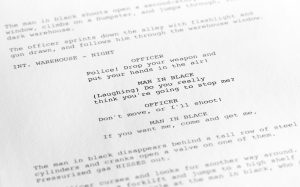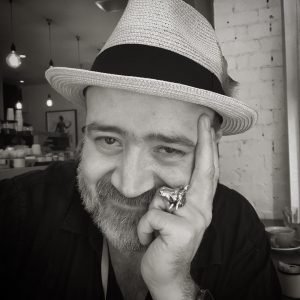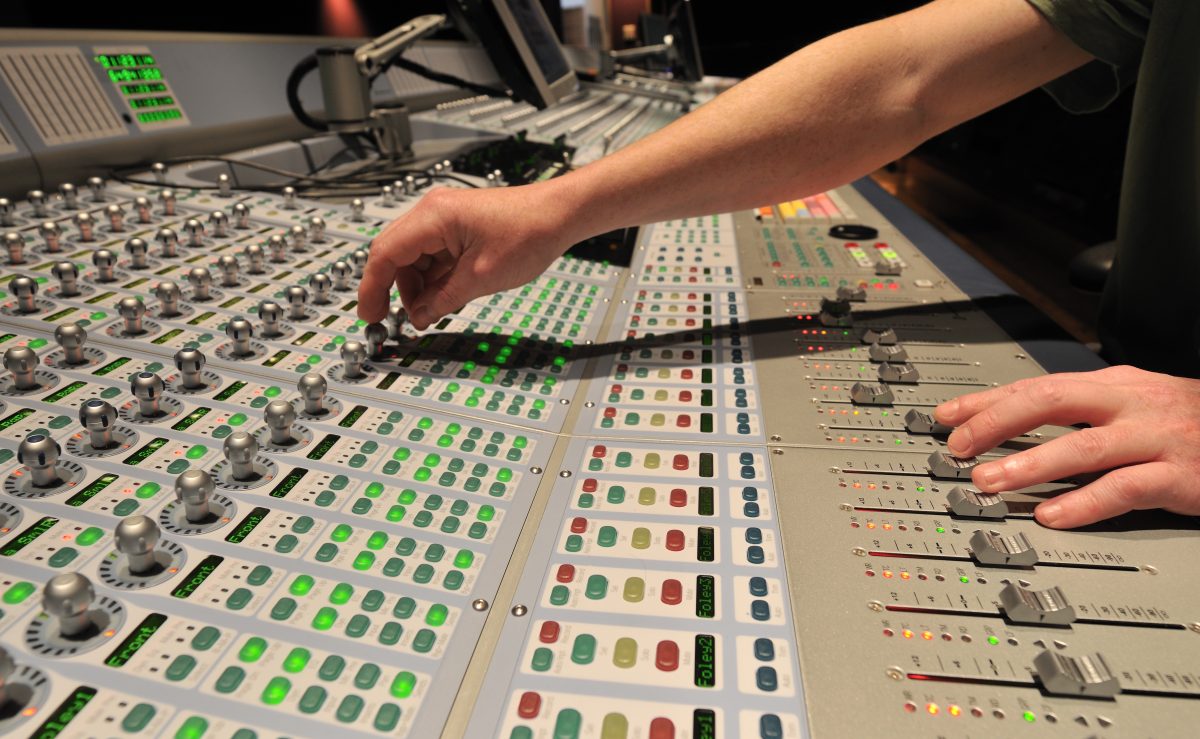In this, the third instalment in our series of articles on ADR, we look at the craft from the ADR Mixer’s point of view.
We do so once again with the help of RTS-Award winning Supervising Sound Editor Chris Roberts.
In the first part of this series on ADR, we crossed the rubicon to the other side of the glass and looked at the craft from the Actor’s perspective.
Now that they’re comfortable and in character, it’s our turn to do the same. The fact you’re reading this means the chances are you’re an audio professional who is, or is likely to one day be, shooting ADR. In this article we’ll put ourselves on the usual side of the equation and examine the role of the person responsible for making the ADR recordings: The ADR Mixer.
Why “ADR Mixer” ?
For the purposes of this article I’ll employ the term ADR Mixer. The main aim of any ADR session is to re-record dialogue which the main Re-Recording Mixer will ultimately be able to make work seamlessly against production dialogue in the final soundtrack. Why, then, don’t we refer to those who create this material as “ADR Engineers” or “ADR Recordists”? In truth, they sometimes are, but to my mind these titles don’t reflect what is truly involved in the process.
As important as capturing a good recording is the ability to play back those recordings in the context of the scene.
The person on the faders has the task of quickly editing the recorded ADR to get a better sync match, then basically providing their colleagues in the studio a temp mix on-the-fly. Mixing across from production sound to ADR and back again, balancing against any sound effects and music from the provided guide track and anything they feel may help from their own libraries. The ADR Mixer is the first person to give the actor, director and ADR Supervisor the confidence that the recorded dialogue will work in the final mix.
To that end – much of the advice that we offered the actor in part 1 is broadly applicable to the ADR Mixer, albeit with a different point of view. So, without further ado:
5 Things ADR Mixers need to know about ADR
1) ADR is not a ‘fix’, a cheat or a dirty secret, it’s part of the storytelling process.
In much the same way as we need to reassure the actor that they aren’t in the ADR studio because someone did something wrong, it’s important that we also approach ADR with a similar confident attitude; that this is part of the storytelling process. It can be a chance to add a final shine to the piece by offering the option to lift a line of important nuanced dialogue, or adapt a performance to better suit its edited form, to connect with the audience in the most effective way possible. The best ADR Mixers know and understand that an ADR session is much more than a purely technical or remedial process.
We’re not here recording ADR because we had to, due to unforeseen circumstances. We’re here because we’re supposed to be. This is how on-screen characters tell stories.
2) Understanding the Actor
In the first article in this series, we looked at why some actors may have little or no experience of shooting ADR, or why they may simply not enjoy the process. For a session to run smoothly, it is critical that a good ADR Mixer is able to empathise with the actor, as well as making the technical aspects of the process as invisible as possible.
Chances are, before they came to your studio, the actor was doing something they much prefer. Now, a stranger in a darkened room is asking them to emote on cue while inhabiting a character they may not have thought about for some time.
From mic-ing up the actor and explaining what to expect from the cueing system, to giving the occasional note from a recording perspective, the best ADR Mixers take a friendly, diplomatic and tactful approach to put the actor at ease and in-the-zone. As ADR Mixers are often staff of a particular facility, many of the busier actors often develop good, regular working relationships with the ADR Mixers as they work with them across many productions over time. In many of the projects I have been involved with, the presence of this reassuring familiarity in the relationship between the actor and the ADR Mixer has been the most important factor in the smooth running of the session. Even if they’ve never worked with the Director or ADR Supervisor before, the actor immediately has an established, confident connection with someone in the room.
3) The ‘only line you need’ isn’t the only line you need

To use a music recording analogy; When dropping in on a solo, the recording engineer has the musician play up to and past that one note or phrase, guiding them to and past the moment, punching in and out of record. ADR is no different.
As we covered in Part 1, re-recording the lines before and after the dialogue to be replaced helps the actor to put the new line into context by giving them the opportunity to deliver that line as part of the performance overall. This helps the actor to match the dialogue from the original performance in terms of pitch, tone, register and most importantly emotion.
Of course, this also provides the ADR Editor and Re-Recording Mixer with options as to where best to cut or mix between ADR and production sound to achieve the best match.
It’s really important for the ADR Mixer to record what has been cued, not just the lines that have ben identified as the most necessary. Good ADR Mixers often suggest adding additional cues (again, tactfully and diplomatically!) as their ear can be more attuned than others in the room as to how the ADR will finally match.
4) ADR is not a voiceover
Here again, in part 1 we made the same observation from the actor’s point of view, and as a piece of advice it’s applicable also to the ADR Mixer. Some actors will subliminally switch into voice-over mode as they cross the threshold of a sound studio. ADR is most definitely not a voice-over performance. This is something that an ADR Mixer is also aware of in how they record. Close positioned, large diaphragm mics are rarely appropriate.
As most ADR recording is about matching into production sound, choice and positioning of microphones is vital. Most often the recordings will be ‘twin track’ (using a boom mic and a personal mic similar to those used on set or location). The best ADR Mixers will be listening to the production sound they are provided with and placing the mics in positions similar to where the production sound mixer placed theirs, to help achieve the same sonic characteristics. They will be moving from their chair to adjust the mic placement, sometimes several times in a scene, the help achieve that all-important match.
In the same way as the Director and ADR Supervisor, they will always… always… be listening for the performance.
5) Fail to prepare, prepare to fail
For an ADR session to run smoothly – it’s all about the homework.
Before a session begins, it’s imperative for the ADR Mixer to know, to really know, what is involved.

The session might be going perfectly: Sound is great, actor is on top form, pages of script are tumbling away as you collectively storm through the session. And that’s it. We’re all done.
I think.
Or are we? This is the last chance saloon. After today there may be no chance of getting the actor back, so are you absolutely sure? This is not the time to make an assumption. It’s also not the time to begin the process of checking.
You need to know for certain what the session involves, what is needed and not needed, before the actor walks into the room. Preparation is all important, because there’s no time in the session, and no good outcome to be had from missing a line and sending the actor on their way
Check the cues from the sheets the ADR Supervisor has provided and load the timecodes for each cue into the prompt system. If there’s time, review the lines from the provided guide track to start tuning in to what will be required from the actor before they arrive.
There are other things to consider and possibly prepare for too. Will it be a remote session? Connecting an actor in the London studio with a director in LA? Has the conection been tested? Are the sessions running in sync? Will there also be a producer listening in from their New York office via a phone patch? Has a Skype video link been requested?
The role of the ADR Mixer ultimately connects everyone involved. Actor, director, ADR Supervisor – balancing their contributions with his or her own set of skills.
The end game of course being to produce recordings that – ideally – the audience will never know were made.
If this article is the first you’ve read in this series on ADR, be sure to check out Part 1 and Part 2 here on Resurface, and stay tuned to the Newsfeed for the next installment.

About the author
Chris Roberts is Head of Sound Editorial at Resound Sound Ltd, and served as Chairman of AMPS (Association of Motion Picture Sound) between 2010 and 2013.
In a career in post production sound spanning more than 20 years, Chris has worked as either Supervising Sound Editor or ADR Mixer on TV projects such as Fortitude, Ripper Street and Episodes; and Feature films such as Star Wars Episode 2, Alien vs Predator, and X-Men 2.
Follow Chris on Twitter @resound_sound



